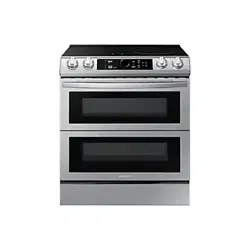Documents: Go to download!
User Manual
- User Manual - (English, French)
- Installation Intructions - (English)
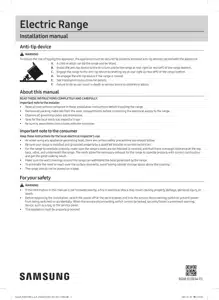
- Introducing your new range
- Operating the oven
- Maintaining your appliance
- Troubleshooting
Table of contents
User manual Induction Range
Introducing your new range
Overview


Operating the oven
The oven control panel

01 START: Press to start oven operation.
02 OFF: Delete all information entered, return to the first step. Stop the oven operation.
03 Time Option: Go to set time options. (Cook time, Delay start)
04 Options: Go to set options.
05 Smart Control: Set Smart Control function On/Off.
06 Light: Tap to turn oven light On/Off.
07 Dial Knob: Turn Clockwise - Move focus to next / increase value.
Turn Counterclockwise - Move focus to previous / decrease value.
Push - Select the current value.
08 Back: Go to upper depth, previous page, etc.
09 Flex duo Oven: Select Upper and Lower oven to use.
How to use dial knob
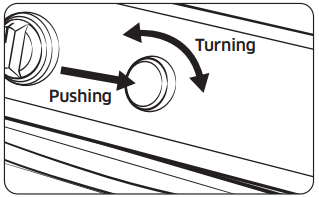
The dial knob can be used in the following ways:
1. Turning
• Turning the dial knob clockwise or counterclockwise will show next or previous mode when selecting the cooking mode.
• Turning the dial knob clockwise or counterclockwise will increase or decrease the value when selecting the cooking temperature or time.
2. Pushing
By pushing the dial knob, current value will be entered.
NOTE Dial knob cannot be disassembled. Do not pull it forcibly.
Lock
This feature lets you lock Oven controls, Cooktop, and Oven door so they cannot be activated accidentally.
How to activate the Lock feature
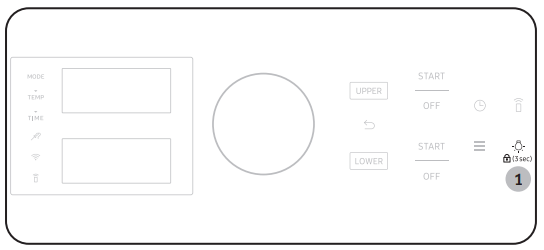
1. Press  for 3 seconds. The lock icon appear in the display as well as the current time. All functions must be cancelled before Lock feature is activated. This function is available only when the oven temperature is under 400 °F.
for 3 seconds. The lock icon appear in the display as well as the current time. All functions must be cancelled before Lock feature is activated. This function is available only when the oven temperature is under 400 °F.
How to unlock the oven and cooktop
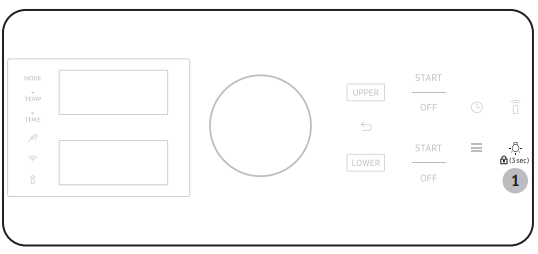
1. Press  for 3 seconds. The lock icon will disappear from the display.
for 3 seconds. The lock icon will disappear from the display.
Display mode
Sleep mode
The control panel enters Sleep mode if the oven is not used for a while. In Sleep mode, the control panel is inactive, displaying only the time, until it is reactivated by the user.
NOTE You can adjust the control panel timeout. (See more information on page 52.)
Wake-Up
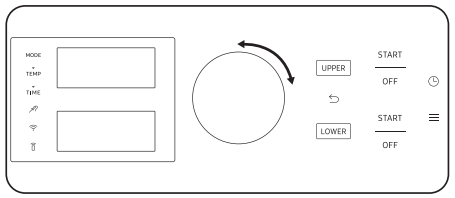
To activate the control panel, turn or push the Dial Knob. User preferences are available in this mode including the timer, oven light, and/or control lock.
Turning the oven light on and off
- The oven light turns on automatically when the door is opened.
- The oven light turns off automatically when the door is closed.
- You can turn the oven light on and off manually by pressing the
 pad.
pad.
Clock
You must set the clock correctly to ensure the automatic features work properly. This product supports two time formats: 12-hour (default) and 24-hour.

To set the clock time
1. Tap  .
.
2. Select Set time using the dial knob.
3. Enter the current time using the dial knob.
4. Push the dial knob to confirm the settings.
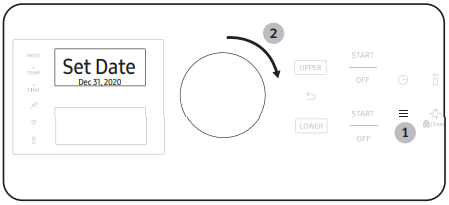
To set the Date
1. Tap  .
.
2. Select Set Date using the dial knob.
3. Enter the current Date using the dial knob.
4. Push the dial knob to confirm the settings.
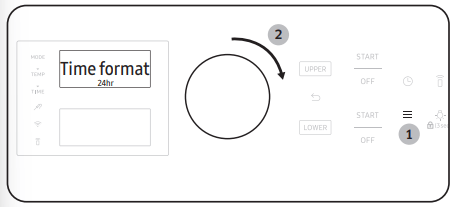
To change the time format (12hr/24hr)
1. Tap  .
.
2. Select Time format using the dial knob.
3. Turn the dial knob to select 12hr or 24hr.
4. Push the dial knob to save the changes.
NOTE You can set/change the clock or the kitchen timer before you start a cooking mode or while most cooking modes are operating. However, you cannot set or change the time if a time based function is operating (Time Bake, for example) or the Sabbath feature is enabled.
Dual Door™
This oven has a unique Dual Door™ that is hinged in the middle. If you have inserted the divider and divided the oven in two (so it is in Twin Mode), you only need to open the top half to access the upper oven. When you’re using the Flex Duo™ capability, you can access the top oven space much more easily and with greater energy efficiency.
How to use the upper door

1. Hold the handle and the lever. Press the lever to release the door latch, and then pull the handle.
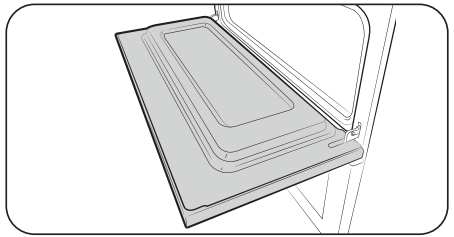
2. This will open only the upper door as shown.
How to use the full door
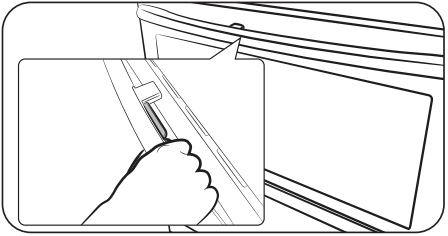
1. Hold the lever-less area of the handle, and then pull.
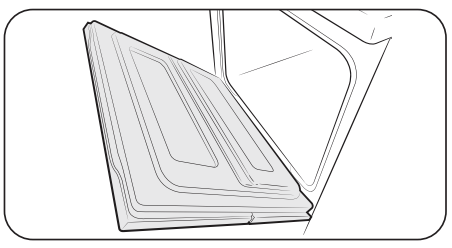
2. This will open the whole door as shown.
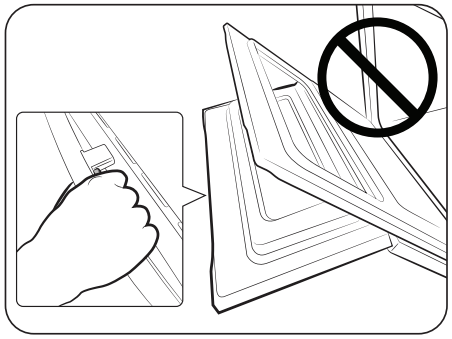
CAUTION When opening the whole door, make sure to grasp the handle by the lever-less portion. If you press the lever halfway through opening the whole door, the upper door may open, causing physical injury
NOTE
• Do not put heavy objects on, or apply excessive force, to the upper door.
• Do not let children play with or on the upper door.
Single mode
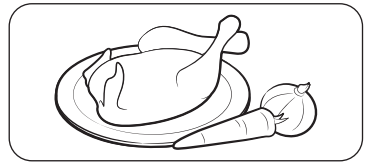
STEP 1 Put all ingredients in a heat-safe container.

STEP 2 Select a cooking mode, and then start preheating.
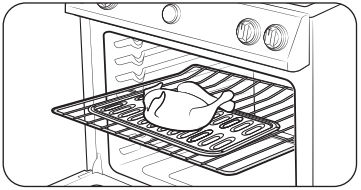
STEP 3 Place the container on a rack.
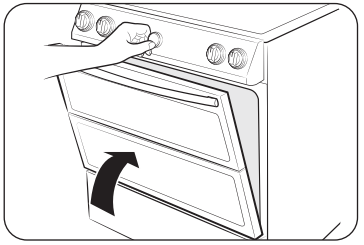
STEP 4 Close the door and start cooking.
NOTE
• The cooling fan automatically runs for a certain amount of time after cooking is complete.
• There can be slight popping sound during oven cooking. This sound may occur during the normal oven burner cycling, when the oven burner flame is extinguished.
Twin mode

STEP 1 Put all ingredients in a heat-safe container.
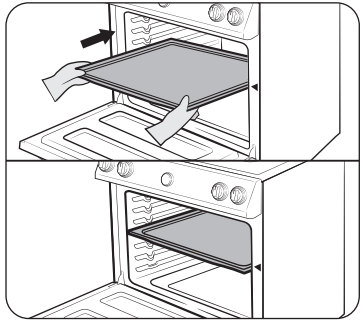
STEP 2 Insert the divider into the 4th rack position and push in until the range beeps.

STEP 3 Select a cooking mode, and then start preheating.
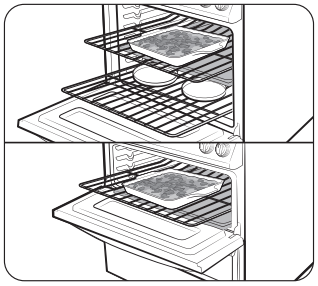
STEP 4 Place a wire rack into the oven, arrange food containers on the racks.

STEP 5 Close the door and start cooking.
NOTE
- To use Twin mode operation, insert the divider.
- The cooling fan automatically runs for a certain amount of time after cooking is complete.
- When you are not using the divider, store it at room temperature.
- Handle the divider with both hands.
- Use oven gloves when inserting or removing the divider.
- Please note that the time for the upper and lower ovens to preheat is different.
- Do not put food containers directly on the divider for cooking purposes.
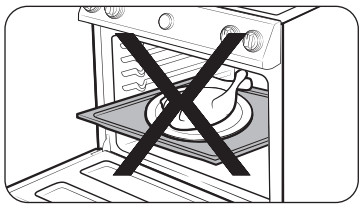
CAUTION
Range displays “-dc-”
- Check the divider to see if it is installed correctly.
- Do not insert/remove the divider during cooking.
Cooking mode
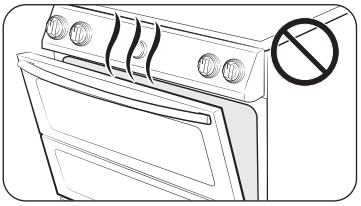
- Make sure to close the door before you start cooking.
- If you leave the door open for about 2 minutes while the oven is in convection baking/roasting, baking, or broiling modes, the oven burner shuts off. To restart the burner, close the door.
Single mode

1. Use the dial knob to select a mode: (Bake, Convection Bake, Convection Roast, Air Fry, Broil, etc.).
2. If necessary, use the dial knob to change the default temperature. You can set the oven to any temperature.
3. Push the dial knob, if necessary, you can set the Cook Time and Delay Start when the "Start" Message displays. Tap START or push the dial knob.
• The oven preheats until it reaches the temperature you set.
• It beeps several times when it reaches the set temperature.
• When preheating is complete, place the food in the oven, and then close the door.
4. When cooking is complete, turn off the oven, and then take out the food.
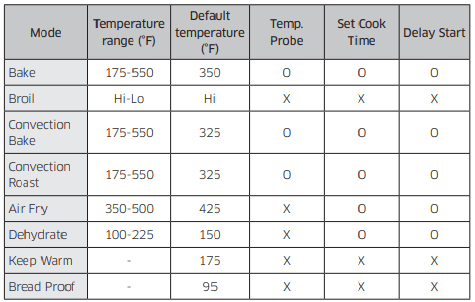
NOTE To change the temperature during cooking, repeat steps 1 through 3 above.
NOTE
If the 12hr energy saving feature is disabled, those modes will operate until canceled. (12hr energy saving's default setting : on)
See page 52 for more information.
Twin mode

1. Insert the divider into the cavity.
2. Tap Upper or Lower to select the cooking zone.
3. Select a mode using the dial knob.
4. If necessary, use the dial knob to change the default temperature. You can set the oven to any temperature.
5. Push the dial knob, if necessary, you can set the Cook Time and Delay Start when the "Start" Message displays. To Start mode, Tap START or push the dial knob.
• The oven preheats until it reaches the temperature you set.
• It will beep several times when it reaches the set temperature.
• When preheating is complete, place the food in the selected oven, and then close the door.
6. When cooking is complete, choose the cavity and turn off the oven.
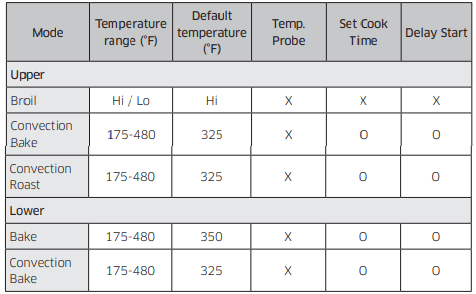
Using the gliding rack
The fully extendable Gliding rack makes food preparation easier, especially when you are preparing heavier dishes. The Gliding rack has 2 glide tracks that allow you to extend the rack well out of the oven without touching the sides of the oven walls.
Installing the Gliding rack
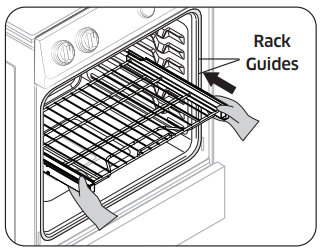
With the Gliding rack in the "Closed" position and the oven off, carefully insert the Gliding rack between the guides until the rack reaches the back.
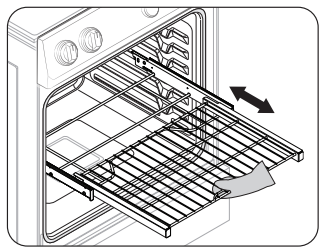
When using the Gliding rack in the oven, be sure to pull on the handle of the rack only to slide it in and out. If you grasp the frame while using the rack, the entire Gliding rack will be removed. Make sure you use oven mitts when handling the Gliding rack during cooking.
Removing the Gliding rack
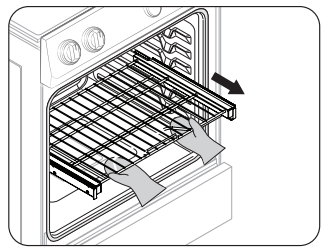
With the Gliding rack in the "Closed" position and the oven off and cool, grasp the rack and frame and pull both forward to remove.
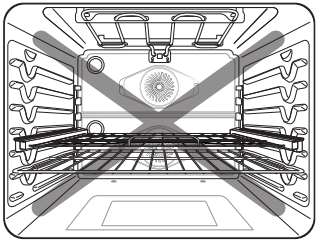
CAUTION
Do not install the Gliding rack directly above the Flat rack.
You will not be able to install it properly and the rack could fall.
NOTE You can install the Gliding rack in any rack positions except the highest (level 7) and lowest (level 1) rack position in the oven.
Using the divider
- To use twin mode operation, insert the divider.
- You cannot use the Self-Clean or Steam-Clean functions when the divider is installed in the oven cavity.
- Handle the divider with both hands.
- Use oven gloves when inserting or removing the divider.
To Install the divider into the Oven Cavity
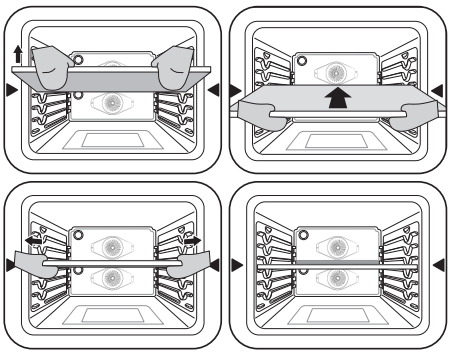
1. Insert the divider into the 4th rack position of the cavity.
2. Push the divider in until its back end rests against the back of the cavity
CAUTION
Range displays "-dC-"
• Check the divider to see if it is installed correctly.
NOTE You can store the divider into the storage drawer.
Broiling
Broiling uses the oven broil burner at the top of the oven to cook and brown food. Meat or fish must be put on a broiling grid in a broiling pan. Preheating for 4 minutes before broiling is recommended.
NOTE
- This oven is designed for closed door broiling. While broiling, keep the door closed. Only open the door to put food in, turn food over, or take food out.
- Use the Broil Rack for the best results.
- Use the Broil LO for poultry or thick cuts of meat to prevent overbroiling.
- Use caution when you open the oven door to turn over the food. The air escaping from the oven will be very hot.
- If you leave the oven door open for more than 2 minutes when the oven is on, all heating elements will shut off automatically.
- When you have finished cooking, the cooling fan will continue to run until the oven has cooled down.
Air fry
This feature uses hot air for crispier and healthier frozen or fresh foods without, or less oil, than normal convection modes. For best results, use this mode on a single oven rack and place the Air fry tray on the position 3. The temperature can be set between 350 °F and 500 °F. Preheating is not necessary for this mode. Follow recipe or package directions for set temperature, time, or quantity.
How to set the oven for Air fry mode
- Place the tray on rack position 3.
- Select Air fry mode using the dial knob.
- Use the dial knob to change the default temperature. Enter the suggested temperature for your food as recommended cooking guide. The default temperature is 425 °F.
- Push the dial knob and set the Cook Time or Delay Start, if necessary.
- Tap START or push the dial knob.
- When cooking is complete, tap OFF and take out the food.
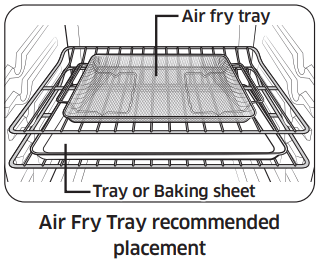
NOTE
- Place a baking sheet or tray on the rack below the Air fry tray for getting any drippings. This will help to reduce splatter and smoke.
- Before using a baking sheet, check the maximum allowable temperature of baking sheet.
- Air fry is designed for a single oven rack. Place food on rack position 3 for best results.
- For cooking fresh or homemade foods, spread the oil over a larger area more evenly, crisping up the food more effectively
Air fry cooking guide
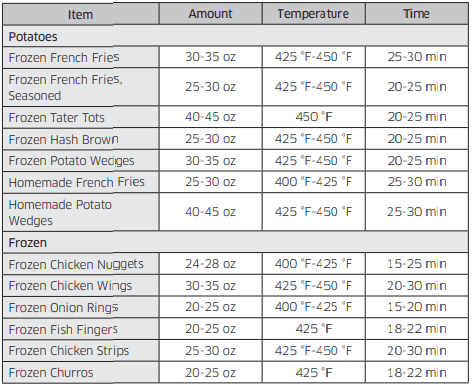

Temperature probe (Single Mode Only)
The temperature probe lets you cook roasts and poultry to the exact internal temperature you want, taking the guess work out of determining whether a piece of meat is done or not.
You can use the temperature probe with the oven set to Bake, Convection Bake, or Convection Roast. When you use the temperature probe, the internal temperature is shown on the display when it reaches 100 °F.

1. Push the temperature probe into the meat so that the tip of the probe reaches the center of the meat.
- When you insert the temperature probe, make sure it does not contact bone, fat, or gristle.
- For bone-in meats, insert the probe into the center of the lowest and thickest portion of the piece.
- For whole poultry (turkey, large chickens, etc.), insert the probe into the thickest part of the inner thigh, parallel to the leg.
- If you remove the temperature probe while cooking is in process, the oven shuts off in 60 seconds.
- The temperature probe may not function properly if inserted into frozen food. (The temperature probe icon doesn’t appear.)
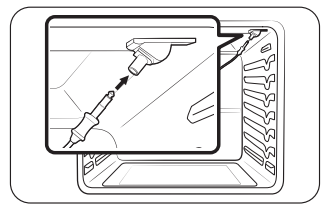
2. Insert the temperature probe plug into the socket on the top side wall of the oven.
3. Select the cooking operation (Convection Bake, Convection Roast, or Bake) and the temperature.
4. Set the internal temperature between 100 °F to 200 °F using the dial knob.

5. Set an option (Delay Start) if necessary.
6. Tap START. When the food reaches the set internal temperature, the oven automatically shuts off, and then beeps.
NOTE
Temperature probe operation will shut off either:
• When cooking time is over.
• When the temperature reaches the temperature you set.
Temperature table

CAUTION
- To protect the temperature probe, be careful not to insert the probe so that it comes out of the meat. Make sure that the probe is inserted around the center of the meat.
- Do not store the probe in the oven.
- Do not leave the probe inside the oven during the Self-Cleaning or Broiling cycle. This will cause permanent damage to the probe.
- To avoid damage to the probe, defrost food in advance.
- Do not use tongs when inserting or removing the probe. Tongs can damage the probe.
- Use the temperature probe only for the applicable cooking operations.
NOTE If you have covered the meat with aluminum foil and you let it stand covered for 10 minutes after cooking is complete, the internal temperature increases by 5-10 °F degrees.
Cooking options
CAUTION Food that can easily spoil, such as milk, eggs, fish, poultry, and meat, should be chilled in a refrigerator before they are placed in the oven. Even when chilled, they should not stand for more than 1 hour before cooking begins and should be removed promptly when cooking is completed.
Cook Time
Timed cooking sets the oven to cook foods at a set temperature for a set length of time. The oven automatically turns off when it finishes. Mode: Bake / Convection Bake / Convection Roast / Air Fry / Dehydrate
1. Start a desired cooking mode, such as Bake.
2. If necessary, change the temperature using the dial knob.
3. When "Start" displays, select Set Cook Time using the dial knob.
4. Set the cooking time between 1 minute and 9 hours and 59 minutes (9:59) using the dial knob.
5. Use the dial knob to select one of the following options you want to run at the end of cooking.
• Oven Off: The oven turns off at the end of cooking. (Default setting)
• Keep temp: Keep running the oven at the current cooking temperature at the end of cooking.
• Keep warm: Activate Keep warm function at the end of cooking.
6. Tap "START". The oven will automatically turn on and start preheating. The temperature will increase until it reaches the temperature you set. The oven starts cooking for the amount of time you set.
7. When preheating is complete, put the container with the food on a rack, and then close the door.
8. When the cooking time has elapsed, the oven will automatically shut off and then beep.
NOTE To change the programmed cooking time, press the  or use the dial knob.
or use the dial knob.
Delay Start
The Delay Start function lets you use the kitchen timer to automatically start and stop another cooking program. You can set Delay Start so that it delays the automatic start of a cooking operation you select by up to 12 hours. Mode: Bake / Convection Bake / Convection Roast / Air Fry / Dehydrate / Self-clean
1. Place the container with the food on a rack, and then close the door.
2. Start a desired cooking mode, such as Bake.
3. If necessary, change the temperature using the dial knob.
4. When "Start" displays, select Set Delay Start using the dial knob.
5. Set the starting time using the dial knob.
6. When "Delay Start" displays, press START or push the dial knob to start.
7. The oven starts cooking at the set time.
NOTE To change the starting time, press the  , or use the dial knob.
, or use the dial knob.
Maintaining your appliance
Self-cleaning
This self-cleaning oven uses high temperatures (well above cooking temperatures) to burn off leftover grease and residue completely or reduce them to a finely powdered ash that you can wipe away with a damp cloth.
CAUTION
- During the self-cleaning cycle, the outside of the range will become very hot to the touch. Do not leave small children unattended near the appliance.
- Some birds are extremely sensitive to the fumes given off during the selfcleaning cycle of any range. Move birds to another well-ventilated room.
- Do not line the oven walls, racks, bottom, or any other part of the range with aluminum foil. Doing so will result in poor heat distribution, poor baking results, and cause permanent damage to the oven interior. Aluminum foil will melt and adhere to the interior surface of the oven.
- Do not force the oven door open. This can damage the automatic door locking system. Use care when opening the oven door after the self-cleaning cycle is complete. Stand to the side of the oven when opening the door to allow hot air or steam to escape. The oven may still be VERY HOT.
- Wear the glove during cleaning.
Before a self-cleaning cycle

• We recommend venting your kitchen with an open window or using a ventilation fan or hood during the selfcleaning cycle.
• Remove the wire rack, broil pan, broil pan insert, all cookware, and any aluminum foil from the oven.
• Wipe up debris from the oven bottom. (Fig. 1)
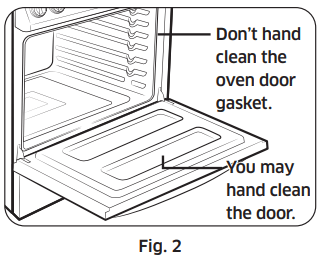
• Residue on the front frame of the range and outside the gasket on the door will need to be cleaned by hand. Clean these areas with hot water, soap-filled steel-wool pads, or cleansers, such as Soft Scrub. Rinse well with clean water and dry.
• Do not clean the gasket. The fiberglass material of the oven door gasket cannot withstand abrasion. It is essential for the gasket to remain intact. If you notice it becoming worn or frayed, have it replaced. (Fig. 2)
• Make sure the oven light bulb cover is in place and the oven light is off.
NOTE Remove oven racks and accessories before starting the self-clean mode.
How to run a self-cleaning cycle
1. Make sure the oven door is closed completely and unlocked. Turn off all oven and cooktop functions.
2. Tap  , and select Cleaning > Self Clean using the dial knob.
, and select Cleaning > Self Clean using the dial knob.
Then, select the cleaning time. (2 hour / 3 hour / 5 hour)
3. Tap START/SET.
The oven door is locked automatically and the oven begins to heat up.
NOTE
- You will not be able to start a self-cleaning cycle if the oven lock feature is activated or if the oven’s temperature is too hot.
- The oven door locks automatically. The display will show the cleaning time remaining. It is not be possible to open the oven door until the temperature drops to a safe/cool temperature.
4. When the self-cleaning cycle is done, End will appear in the display and the range will beep several times.
How to delay the start of self-cleaning
- Repeat steps 1 and 2 on 'How to run a self-cleaning cycle'.
- Select Set Delay Start.
- Set the time you want the oven to start self-cleaning using the dial knob.
- Tap START/SET.
The oven will start self-cleaning at your specified time.
How to turn off the self-cleaning feature
You may find it necessary to stop or interrupt a self-cleaning cycle due to smoke in the oven.
- Press OFF.
- You will be able to open the oven door once the oven has cooled down for approximately 1 hour.
After a self-cleaning cycle
- You may notice some white ash in the oven. Wipe it up with a damp cloth after the oven cools. (If white spots remain, remove them with a soap-filled steel wool pad and rinse thoroughly with a vinegar and water mixture.)
- If the oven is not clean after one cycle, repeat the cycle.
- You cannot set the oven for cooking until the oven is cool enough for the door to unlock.
Steam-cleaning
How to set the oven for steam-cleaning
For light cleaning, the steam-cleaning function saves time and energy. For heavierduty cleaning, use the self-cleaning function.
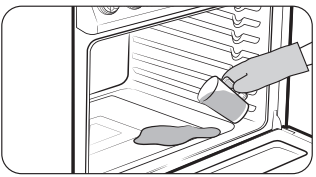
1. Remove all accessories from the oven.
2. Pour approximately 1 ¾ cups of water onto the bottom of the empty oven and then close the oven door. Use normal water only, not distilled water.
3. Tap  , and select Cleaning > Steam Clean using the dial knob.
, and select Cleaning > Steam Clean using the dial knob.
4. Tap START/SET. The oven door is locked automatically and the oven begins to heat up. When the operation is complete, a beep will sound.
5. Press OFF.
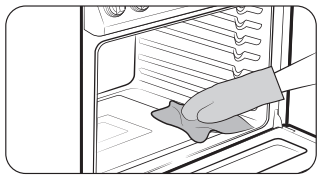
6. Clean the oven’s interior. There will be a significant amount of water remaining on the bottom of the oven after a steam-cleaning cycle. Remove the residual water with a sponge or soft dry cloth.
NOTE When steam-cleaning, use exactly 10 oz. of water since this produces the best results.
NOTE If you press Steam Clean when the oven temperature is above 100˚F, Hot will appear in the display. Because this function produces the best results when started while the oven is cool, we recommend that you wait until the oven has cooled down and Hot disappears from the display.
CAUTION Wear the glove during cleaning.
After a steam-cleaning cycle
- Take care when opening the door before a steam-cleaning procedure has ended. The water on the bottom is hot.
- Open the oven door and remove the remaining water with a sponge. Do not leave the residual water in the oven for any length of time. Wipe the oven clean and dry with a soft cloth. Do not forget to wipe under the oven door seal.
- Use a detergent-soaked sponge, a soft brush, or a nylon scrubber to wipe the oven interior. Remove stubborn residue with a nylon scourer. You can remove lime deposits with a cloth soaked in vinegar.
- If the oven remains dirty, you can repeat the procedure once the oven has cooled.
- For heavy residue, such as grease left over from roasting, we recommend that you rub detergent into the residue before activating the steam-cleaning function.
- After cleaning, leave the oven door ajar at a 15° angle to allow the interior enamel surface to dry thoroughly
Care and cleaning of the oven
Vent
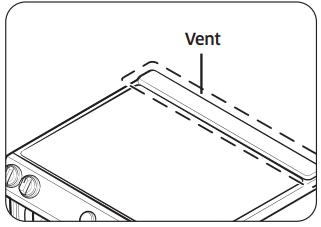
- The cooling vents are located at the back of the oven range.
- This area could become hot during oven use.
- It is normal for steam to come out of the vent.
- The vent is important for proper air circulation. Never block this vent.
Cleaning painted parts and decorative trim
- For general cleaning, use a cloth with hot, soapy water.
- For more difficult residue and built-up grease, apply a liquid detergent directly onto the area and leave for 30 to 60 minutes. Wipe with a damp cloth and dry. Do not use abrasive cleaners on any of these surfaces. They can scratch.
Cleaning stainless steel surfaces
1. Shake the bottle of Stainless Steel Appliance Cleaner or Polish well.
2. Place a small amount of Stainless Steel Appliance Cleaner or Polish on a damp cloth or damp paper towel.
3. Clean a small area, rubbing with the grain of the stainless steel if applicable.
4. Dry and buff with a clean, dry paper towel or soft cloth.
5. Repeat as necessary
NOTE
- Do not use a steel-wool pad. It will scratch the surface.
- If a mineral oil-based stainless steel appliance cleaner has been used before to clean the appliance, wash the surface with dishwashing liquid and water prior to using the Stainless Steel Appliance Cleaner or Polish.
Oven racks
- If the racks are left in the oven during a self-cleaning cycle, their color will turn slightly blue and the finish will be dull. After the self-cleaning cycle is complete and the oven has cooled, rub the sides of the racks with wax paper or a cloth containing a small amount of oil. This will help the racks glide more easily on their tracks.
- Gliding racks may be cleaned by hand with an abrasive cleaner or steel wool. During cleaning, be careful not to allow water or cleaner to enter the slides on the sides of rack.
NOTE
- Do not clean in a dishwasher.
- If the rack becomes hard to remove or replace, lightly wipe the oven rack guides with cooking oil. Do not wipe cooking oil on the slides.
- If the rack becomes difficult to slide, the rack may need to be lubricated using a graphite lubricant.
Oven door
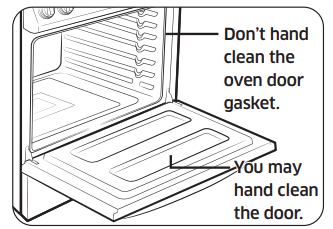
- Use soap and water to thoroughly clean the top, sides, and front of the oven door. Rinse well. You may use a glass cleaner on the outside glass of the oven door. DO NOT immerse the door in water. DO NOT spray or allow water or the glass cleaner to enter the door vents. DO NOT use oven cleaners, cleaning powders, or any harsh abrasive cleaning materials on the outside of the oven door.
- DO NOT clean the oven door gasket. The oven door gasket is made of a woven material which is essential for a good seal. Care should be taken not to rub, damage, or remove this gasket.
Care and cleaning of the glass cooktop
Normal daily use cleaning
Use only a ceramic cooktop cleaner. Other creams may not be as effective.
By following these steps, you can maintain and protect the surface of your glass cooktop.
- Before using the cooktop for the first time, clean it with a ceramic cooktop cleaner. This helps protect the top and makes cleanup easier.
- Daily use of a ceramic cooktop cleaner will help keep the cooktop looking new.
- Shake the cleaning cream well. Apply a few drops of cleaner directly to the cooktop.
- Use a paper towel or a cleaning pad for ceramic cooktops to clean the entire cooktop surface.
- Use a dry cloth or paper towel to remove all cleaning residue. No need to rinse.
WARNING DAMAGE to your glass surface may occur if you use scrub pads other than those recommended.
Removing burned-on residue

- Allow the cooktop to cool.
- Spread a few drops of ceramic cooktop cleaner on the entire burned residue area.
- Using a cleaning pad for ceramic cooktops, rub the residue area, applying pressure as needed.
- If any residue remains, repeat the steps listed above as needed.
- For additional protection, after all residue has been removed, polish the entire surface by applying ceramic cooktop cleaner with a paper towel.
Troubleshooting
Troubleshooting
Samsung works hard to ensure that you don’t have problems with your new electric range. If you run into unexpected trouble, look first for a solution in the tables below. If you’re still having trouble after trying the suggested solution, call Samsung at 1-800-SAMSUNG (1-800-726-7864).
Installation
Problem | Possible cause | Solution |
The range is not level. | The appliance has been installed improperly. | • Place the oven rack in the center of the oven. Place a level on the oven rack. Adjust the leveling legs at the base of the range until the oven rack is level. • Insure the floor is level and strong and stable enough to adeguately support the range. |
The floor is sagging or sloping. | Contact a carpenter to correct the situation. | |
The kitchen cabinets are not properly aligned and make the range appear to be not level. | Insure the cabinets are sguare and provide sufficient room for installation. | |
The appliance must be accessed for servicing and cannot be moved easily. | The kitchen cabinets are not sguare and too close to the appliance. | Contact a builder or installer to make the appliance accessible. |
Carpet is interfering with movement of the range. | Provide sufficient space so the range can be lifted over the carpet. |
CONTROL DISPLAY
Problem | Possible cause | Solution |
The display goes blank. | A fuse in your home may be blown or the circuit breaker tripped. | Replace the fuse or reset the circuit breaker. |
The display flashes. | There was a power failure. | Reset the clock. |
COOKTOP
Problem | Possible cause | Solution |
The surface units will not maintain a rolling boil or will not cook fast enough. | You may be using inappropriate cookware. | Use pans that are flat and match the diameter of the surface unit selected. |
In some areas, the power (voltage) may be low. | Cover the pan with a lid until the desired heat is obtained. | |
The surface units will not turn on. | A fuse in your home may be blown or a circuit breaker may have tripped. | Replace the fuse or reset the circuit breaker. |
The cooktop controls are set improperly. | Check if the correct control is set for the surface unit you are using. | |
Areas of discoloration on the cooktop. | Food spillover was not cleaned. | Refer to the section on the care and cleaning of the glass cooktop on page 62. |
The surface is hot and the model features a light-colored cooktop. | This is normal. The surface may appear discolored when it is hot. This is temporary and will disappear as the glass cools. |
Problem | Possible cause | Solution |
The surface unit frequently cycles on and off. | The element will cycle on and off to maintain the power setting. | This is normal operation, and not a system failure. Use the range as usual. |
The surface unit stops glowing when changed to a lower setting. | This is normal. The unit is still on and hot. | |
Scratches or abrasions on the cooktop surface. | The cooktop is being cleaned improperly. | Scratches are not removable. Tiny scratches will become less visible in time as a result of cleaning. Use ceramic glass top cleaning cream. Do not use chemical or corrosive agents. These agents may damage the surface of the product. |
Cookware with rough bottoms was used on the cooktop or there were coarse particles (e.g., salt or sand) present between the cookware and the surface of the cooktop. | To avoid scratches, follow the recommended cleaning procedures. Make sure cookware bottoms are clean before use, and use cookware with smooth bottoms. | |
Cookware has been slid across the cooktop surface. | ||
Problem | Possible cause | Solution |
Brown streaks or specks. | Boilovers have been cooked onto the surface. | • Wait until the surface cools down. Then, use a single-edge razor-blade scraper at approximately a 45° angle against the glass surface to remove the soil. • See the section on the care and cleaning of the glass cooktop on page 62. |
Areas of discoloration with metallic sheen. | Mineral deposits from water and food have been left on the surface of the cooktop. | • Remove using a ceramic-glass cooktop cleaning cream. • Use cookware with clean, dry bottoms. Clean the cooktop with a ceramic cleaning agent regularly every week. |
"Cracking" or "popping" sound. | This is the sound of the metal heating and cooling during both the cooking and self-cleaning functions. | This is normal operation, and not a system failure. Use the range as usual. |
OVEN
Problem | Possible cause | Solution |
The oven will not turn on. | The range is not completely plugged into the electrical outlet. | Make sure the electrical plug is inserted into a live, properly grounded outlet. |
A fuse in your home may be blown or a circuit breaker may have tripped. | Replace the fuse or reset the circuit breaker. | |
The oven controls have been set improperly. | See the chapter on operating the oven starting on page 31. | |
The oven is too hot. | Allow the oven to cool. | |
Incomplete service wiring. | Call for service. | |
Power outage. | Check to see if the house lights will turn on. If necessary, call your local electric company for service. | |
The oven light will not turn on. | The light bulb is loose or defective. | Tighten or replace the bulb. |
The switch operating the light is broken. | Call for service. | |
The appliance will not turn on. | The appliance is not completely plugged into the electrical outlet or a fuse in your home may be blown or a circuit breaker may have tripped. | Make sure the power cord is plugged into a live, properly grounded outlet. Check the fuse and circuit breakers. |
Incomplete service wiring. | Call for service. | |
Power outage. | Check to see if the house lights will turn on. If necessary, call your local electric company for service. |
Problem | Possible cause | Solution |
The oven smokes excessively during broiling. | The oven controls have not been set properly. | Refer to the section on using the broiler starting on page 44. |
The meat has been placed too close to the element. | Reposition the rack to provide proper clearance between the meat and the element. Preheat the broil element for searing. | |
The meat has not been properly prepared. | Remove the excess fat from the meat. Cut away fatty edges that may curl, leaving the lean intact. | |
Grease has built up on oven surfaces. | Regular cleaning is necessary when broiling frequently. | |
Food does not bake or roast properly. | The oven controls have not been set correctly. | See the chapter on operating the oven starting on page 31. |
The oven rack has been positioned incorrectly or is not level. | See the section on using the oven racks on page 39. | |
Incorrect cookware or cookware of improper size is being used. | ||
The oven sensor needs to be adjusted. | See the section on adjusting the thermostat on page 53. |
Problem | Possible cause | Solution |
Food does not broil properly. | The serving size may not be appropriate. | Refer to the cooking guide for serving sizes on page 44, and then try again. |
The rack has not been properly positioned. | See the broiling recommendation guide on page 44. | |
The cookware is not suited for broiling. | Use suitable cookware. | |
In some areas, the power (voltage) may be low. | • Preheat the broil element for 10 minutes. • See the broiling recommendation guide on page 44. | |
The oven temperature is too hot or too cold. | The oven sensor needs to be adjusted. | See the section on adjusting the thermostat on page 53. |
The oven will not self-clean. | The oven temperature is too high to start a self-clean operation. | Allow the range to cool and then reset the controls. |
The oven controls have been set incorrectly. | See the section on selfcleaning on page 57. | |
A self-cleaning cycle cannot be started if the oven lock feature has been activated or if a cooktop element is on. | Deactivate the oven lock (see page 32). Make sure all surface elements are turned off. |
Problem | Possible cause | Solution |
Excessive smoking during a self-cleaning cycle. | There is excessive soiling in the oven. | Press OFF. Open the windows to rid the room of smoke. Wait until the self-cleaning cycle is cancelled. Wipe up the excessive soil and then start the self-cleaning cycle again. |
The oven door will not open after a selfcleaning cycle. | The oven is too hot. | Allow the oven to cool. |
The oven is not clean after a self-cleaning cycle. | The oven controls were not set correctly. | See the section on selfcleaning on page 57. |
The oven was heavily soiled. | Wipe up heavy spillovers before starting the selfcleaning cycle. Heavily soiled ovens may need to be self-cleaned again or for a longer period of time. | |
Steam is coming out of the vent. | When using the convection feature, it is normal to see steam coming out of the oven vent. | This is normal operation and not a system failure. Use the range as usual. |
As the number of racks or amount of food being cooked increases, the amount of visible steam will increase. | ||
A burning or oily odor is coming from the vent. | This is normal in a new oven and will disappear in time. | • To speed the process, set a self-cleaning cycle for a minimum of 3 hours. • See the section on selfcleaning on page 57. |
Problem | Possible cause | Solution |
Strong odor. | An odor coming from the insulation around the inside of the oven is normal for the first few times the oven is used. | Operate the oven empty on the bake setting at 400 ,:,F for 1 hour. |
Fan noise. | A convection fan may automatically turn on and off. | This is not a system failure but normal operation. |
Oven fan is making a noise, or won't turn off. | The cooling fan is not visible, but you will hear it running whenever the electronics get hot and turn off when the electronics are cool. | This is normal operation to cool the oven, cooling fan automatically shuts down when the oven cools. |
Oven racks are difficult to slide. | The shiny, silver-colored racks were cleaned in a selfcleaning cycle. | Apply a small amount of vegetable oil to a paper towel, and then wipe the edges of the oven racks with the paper towel. |
DRAWER
Problem | Possible cause | Solution |
The drawer does not slide smoothly or drags. | The drawer is out of alignment. | Fully extend the drawer and push it all the way in. See page 65. |
The drawer is overloaded or the load is unbalanced. | Reduce weight. Redistribute drawer contents. | |
Excessive condensation in the drawer. | There is liguid present in the drawer. | Remove the liguid. |
Uncovered foods. | Cover food with a lid. |
Information codes
OVEN
Displayed code | Possible cause | Solution |
C-dO | There is a short in the dial knob. | Press OFF, and then restart the oven. If the problem persists, disconnect all power to the range for at least 30 seconds and then reconnect the power. If this does not solve the problem, call for service. |
C-d1 | The door lock is misaligned. | |
C-FO | This code occurs if communication between the Main and Sub PBA is interrupted. | |
C-F2 | This code occurs if communication between the Main and Touch is interrupted. | |
C-20 | The oven sensor is open when the oven is operating. | |
There is a short in the Oven sensor. | ||
C-21 | This code occurs if the internal temperature rises abnormally high. |
Displayed code | Possible cause | Solution |
C-22 | The sub PCB sensor is open when the oven is operating. | Press OFF, and then restart the oven. If the problem persists, disconnect all power to the range for at least 30 seconds and then reconnect the power. If this does not solve the problem, call for service. |
There is a short in the sub PCB sensor. | ||
C-23 | The temperature probe sensor is short when the oven is operating. | |
C-30 | The main PCB sensor is open when the oven is operating. | |
There is a short in the main PCB sensor. | ||
C-31 | This code occurs if the PCB temperature rises abnormally high. | Call for service |
-dC- | This code appears if the divider is inserted or removed while the oven is operating. | Make sure the divider is inserted properly, and then restart the oven. If the problem persists, disconnect all power to the range for at least 30 seconds and then reconnect the power. If this does not solve the problem, call for service. |
Displayed code | Possible cause | Solution |
Bad line | This error message appears if the power cord is installed improperly. | If the power connection is plugged in improperly, that code appears on the display. Reconnect the power connection properly, and the message disappears. |
C-A2 | This code occurs if the sub PCB temperature rises abnormanlly high. | Press OFF. Check the oven vent and cooling vent. If the vent is closed, never block the vent by anything. After cooling the oven, restart the oven. If this does not solve the problem, call for service. |
COOKTOP
Displayed code | Possible cause | Solution |
| This code occurs if communication between the Main and Inverter PBA is interrupted. | Turn the knob to Off, and then turn it to the setting you want again. If the problem persists, disconnect all power to the range for at least 30 seconds and then reconnect the power. If this does not solve the problem, call for service. |
| The top sensor is open when the burner is operating. | Call for service |
The top sensor is short when the burner is operating. | ||
| The IGBT sensor is open when the burner is operating. | |
The IGBT sensor is short when the burner is operating. | ||
| This code occurs if the DC fan motor is open or locked. | |
| Displayed if the cookware on an element is unsuitable or too small or no cookware has been placed on the cooking zone. | Check the cookware |
| Displayed if an element knob was set to an On position when the Sabbath or Self-clean mode has ended or been cancelled, and the burner was not able to detect pan during 30 seconds. | To return the display to normal and use the cooktop, turn the knob to the Off position. |
| This code appears if the internal temperature of a burner rises abnormally high. | Turn the knob to Off, and then turn it to the setting you want again. If the problem persists, disconnect all power to the range for at least 30 seconds and then reconnect the power. If this does not solve the problem, call for service. |
See other models: NE63A6711SS/AC NE63A6711SG/AC NE63A6511SW/AC DVE50T5205W/AC DVE45T3200W/AC







